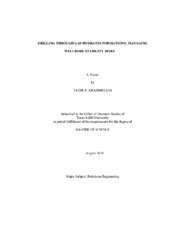| dc.contributor.advisor | Teodoriu, Catalin | |
| dc.contributor.advisor | Falcone, Gioia | |
| dc.creator | Khabibullin, Tagir R. | |
| dc.date.accessioned | 2010-10-12T22:31:50Z | |
| dc.date.accessioned | 2010-10-14T16:07:45Z | |
| dc.date.available | 2010-10-12T22:31:50Z | |
| dc.date.available | 2010-10-14T16:07:45Z | |
| dc.date.created | 2010-08 | |
| dc.date.issued | 2010-10-12 | |
| dc.date.submitted | August 2010 | |
| dc.identifier.uri | https://hdl.handle.net/1969.1/ETD-TAMU-2010-08-8352 | |
| dc.description.abstract | As hydrocarbon exploration and development moves into deeper water and
onshore arctic environments, it becomes increasingly important to quantify the drilling
hazards posed by gas hydrates.
To address these concerns, a 1D semi-analytical model for heat and fluid transport
in the reservoir was coupled with a numerical model for temperature distribution along
the wellbore. This combination allowed the estimation of the dimensions of the hydratebearing
layer where the initial pressure and temperature can dynamically change while
drilling. These dimensions were then used to build a numerical reservoir model for the
simulation of the dissociation of gas hydrate in the layer. The bottomhole pressure
(BHP) and formation properties used in this workflow were based on a real field case.
The results provide an understanding of the effects of drilling through hydratebearing
sediments and of the impact of drilling fluid temperature and BHP on changes in
temperature and pore pressure within the surrounding sediments. It was found that the
amount of gas hydrate that can dissociate will depend significantly on both initial
formation characteristics and bottomhole conditions, namely mud temperature and pressure. The procedure outlined suggested in this work can provide quantitative results
of the impact of hydrate dissociation on wellbore stability, which can help better design
drilling muds for ultra deep water operations. | en |
| dc.format.mimetype | application/pdf | |
| dc.language.iso | en_US | |
| dc.subject | hydrates | en |
| dc.subject | drilling through hydrates | en |
| dc.subject | wellbore stability | en |
| dc.subject | gas-hydrate bearing sediments | en |
| dc.title | Drilling Through Gas Hydrates Formations: Managing Wellbore Stability Risks | en |
| dc.type | Book | en |
| dc.type | Thesis | en |
| thesis.degree.department | Petroleum Engineering | en |
| thesis.degree.discipline | Petroleum Engineering | en |
| thesis.degree.grantor | Texas A&M University | en |
| thesis.degree.name | Master of Science | en |
| thesis.degree.level | Masters | en |
| dc.contributor.committeeMember | Lyle, Mitch | |
| dc.type.genre | Electronic Thesis | en |
| dc.type.material | text | en |


